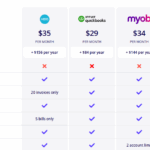Most Clients Don’t Like Paying an Hourly Rate … Unless It’s a Low One

Settling on a pricing structure for your new business is something many new independent contractors agonise over, particularly those in the professional services space. As a contractor or consultant, the de facto pricing structure has always been an hourly rate – indeed, in our Business StartUp Online Training Course you learn how to set your prices based on an hourly rate – but it isn’t the only way. Furthermore, hourly rate often doesn’t serve either the client or the employee best, as explained in a previous post.
For many independent contractors, the greatest barrier to getting hired is their hourly rate. And yet hourly rate prevails as a very popular way of billing for many bookkeepers (so it’s well worth having a solid understanding of the industry rates for bookkeepers if thinking of hiring or becoming one). But understandably, hourly rate represents uncertainty. Each time someone hires an independent contractor on an hourly rate, they nervously sit and watch the clock. Just as you do each time you get in a taxi. Every minute represents another dollar, and as a consequence, businesses looking to hire independent contractors often look for the cheapest available.
When you live in a world where everything should be cheap or free and nothing else, this is to be expected. Unfortunately, though, few people can carve out a living for themselves on cheap or free. That’s why I think independent contractors should consider revising their pricing structures, and adopting a new one – like a PBR system (I’ll explain what that stands for later).
There are a lot of independent contractors that already use different pricing structures to bill their clients. At the end of the day, you’re looking to find a way that best suits you of providing maximum amount of value in exchange for your fee. Consider these different billing models:
Writing and Content Marketing (Per word)
Freelance writers and journalists are paid per word, which varies depending on the arrangement they make with the publication they’re writing for. This ensures that the writer is adequately remunerated for all of the time they put into their articles, rather than just the time they spent actually writing them up – the theory is that the longer the article, the more research required, and each type of article commands a different word rate (columns and opinion pieces earn less than news stories and features).
Bookkeepers, SEO & Digital Marketing Services (Monthly fees)
Some contractors charge their clients a monthly fee for their services. From bookkeepers to lawyers to online marketers – they’re all moving towards subscription-based pricing as a way to offer value to their clients, without having to adulterate their rates in order to stay competitive. Under this arrangement, the client has access to a number of services or certain number of hours of work from the contractor for a set fee.
Real Estate Sales Agents (Retainers)
Most sales people work on commission, a pretty well known fact. In order to make it through the lean times, when they’re working on closing a sale and whatnot, they’re paid a retainer, usually on a weekly basis and usually an amount equal to an average salary. Once the sales person gets their commission for the month or quarter, they pay back the retainer and keep the excess.
Builders & Tradies (Per project)
There are plenty of project managers, web designers, architects and builders, authors, business consultants – you name the profession – that work on a per project basis at times. Web designers usually have a set fee for the makeup of a website – $90, say, for two pages, including graphics and what have you. For longer projects, an overall fee is negotiated and then paid in parts when the contractor reaches certain stages of the project.
PBRs Explained (Performance Based Reward)
Now, and this is where that mysterious little acronym above comes into play. In each of the above examples, these pricing structures are actually examples of a PBR, or Performance Based Reward. The reason I waited to tell you what PBR stands for until now is because I’ve found that most people consider the term ‘performance based reward’ as being some sort of scam. They imagine poor contractors, working themselves to the bone only to be told they haven’t “performed well enough” to get paid.
But that’s not what PBRs are at all. A PBR is just a better, more efficient method of billing clients that is beneficial to both the contractor and the client. In fact, I have a number of contractors who work for me, who bill me on a PBR basis because it’s easier for them and gives them the flexibility complete work when they have the time, not at a prescribed time.
***
I think the PBR pricing structure is the future of the professional service industry, particularly for home-based workers and contractors. What do you think?
If you’d like to learn more about setting prices for small business, enrol in our Business StartUp Course.


















